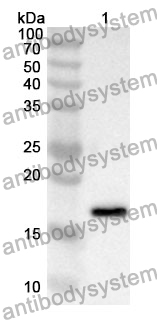Catalog No.
PHC25301
Species reactivity
Human, Mouse, Rat
Host species
Rabbit
Isotype
IgG
Clonality
Polyclonal
Immunogen
E. coli - derived recombinant Human CTSD (Arg23-Gln161).
Tested applications
ELISA: 1:4000-1:8000, IHC: 1:50-1:100, WB: 1:1000-1:4000
Target
CPSD,CTSD,Cathepsin D
Concentration
1.53 mg/ml
Purification
Purified by antigen affinity column.
Accession
P07339
Applications
ELISA, IHC, WB
Form
Liquid
Storage buffer
0.01M PBS, pH 7.4, 50% Glycerol, 0.05% Proclin 300.
Stability and Storage
Use a manual defrost freezer and avoid repeated freeze thaw cycles. Store at 2 to 8°C for frequent use. Store at -20 to -80°C for twelve months from the date of receipt.
Antibodies against the multifaceted cathepsin D protein open new avenues for TNBC immunotherapy., PMID:39800383
Terminal Complement Activation Is Induced by Factors Released from Endplate Tissue of Disc Degeneration Patients and Stimulates Expression of Catabolic Enzymes in Annulus Fibrosus Cells., PMID:36980228
A bibliometric review of peripartum cardiomyopathy compared to other cardiomyopathies using artificial intelligence and machine learning., PMID:35340600
LAMP3 inhibits autophagy and contributes to cell death by lysosomal membrane permeabilization., PMID:34802379
The c.863A>G (p.Glu288Gly) variant of the CTSD gene is not associated with CLN10 disease., PMID:34331747
LRRK2 is required for CD38-mediated NAADP-Ca2+ signaling and the downstream activation of TFEB (transcription factor EB) in immune cells., PMID:34313548
Overexpression of Lipocalin-2 Inhibits Proliferation and Invasiveness of Human Glioblastoma Multiforme Cells by Activating ERK Targeting Cathepsin D Expression., PMID:34062746
A 9-kDa matricellular SPARC fragment released by cathepsin D exhibits pro-tumor activity in the triple-negative breast cancer microenvironment., PMID:33995652
CREG1 promotes lysosomal biogenesis and function., PMID:33966596
Trehalose causes low-grade lysosomal stress to activate TFEB and the autophagy-lysosome biogenesis response., PMID:33706671
Immunoproteomics approach revealed elevated autoantibody levels against ANXA1 in early stage gallbladder carcinoma., PMID:33261560
Arsenic induces mTOR-dependent autophagy, whereas it impairs the autophagy-lysosome pathway and the potential role of TFEB in cultured dendritic cells., PMID:32519707
Pyrroloquinoline quinine ameliorates doxorubicin-induced autophagy-dependent apoptosis via lysosomal-mitochondrial axis in vascular endothelial cells., PMID:31226464
Nutrient deprivation and lysosomal stress induce activation of TFEB in retinal pigment epithelial cells., PMID:31160892
Anxa2- and Ctsd-knockout CHO cell lines to diminish the risk of contamination with host cell proteins., PMID:30972970
Lack of Cathepsin D in the Renal Proximal Tubular Cells Resulted in Increased Sensitivity against Renal Ischemia/Reperfusion Injury., PMID:30959855
Investigation of cathepsin D-mAb interactions using a combined experimental and computational tool set., PMID:30882893
Immunotherapy of triple-negative breast cancer with cathepsin D-targeting antibodies., PMID:30717773
Lysosomes, autophagosomes and Alzheimer pathology in dementia with Lewy body disease., PMID:29748975
Histochemical characteristics of regressing vessels in the hyaloid vascular system of neonatal mice: Novel implication for vascular atrophy., PMID:29596849
Proteomic Analysis of Host Cell Protein Dynamics in the Culture Supernatants of Antibody-Producing CHO Cells., PMID:28281648
High-mobility group box 1 is an important mediator of microglial activation induced by cortical spreading depression., PMID:27142867
Altered lysosomal proteins in neural-derived plasma exosomes in preclinical Alzheimer disease., PMID:26062630
Blood mRNA expression profiling predicts survival in patients treated with tremelimumab., PMID:24721645
Olfactory deficits in Niemann-Pick type C1 (NPC1) disease., PMID:24391715
Apoptosis-related proteins are potential markers of neonatal hypoxic-ischemic encephalopathy (HIE) injury., PMID:24269372
Cathepsin D stimulates the activities of secreted plasminogen activators in the breast cancer acidic environment., PMID:24026424
Immunohistochemical analysis of macroautophagy: recommendations and limitations., PMID:23242143
Localization of cathepsin D in mouse reproductive tissues and its acquisition onto sperm surface during epididymal sperm maturation., PMID:23177142
The immunohematologic and patient safety benefits of a centralized transfusion database., PMID:22803792
Activation and alteration of lysosomes in multiple system atrophy., PMID:22343695
Roles of αvβ5, FAK and MerTK in oxidative stress inhibition of RPE cell phagocytosis., PMID:22138557
Clinical utility of serum autoantibodies detected by protein microarray in melanoma., PMID:22084687
Comparison of candidate serologic markers for type I and type II ovarian cancer., PMID:21704359
Autophagy activation in the injured photoreceptor inhibits fas-mediated apoptosis., PMID:21421874
The role of autophagy emerging in postinfarction cardiac remodelling., PMID:21406597
Serum autoantibody profiling using a natural glycoprotein microarray for the prognosis of early melanoma., PMID:20879797
Anti-p53 antibodies in serum: relationship to tumor biology and prognosis of breast cancer patients., PMID:19763913
Isolation, activity and immunological characterisation of a secreted aspartic protease, CtsD, from Aspergillus fumigatus., PMID:17275325

